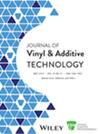Synergistic effect of graphene oxide on the properties of poly (vinyl alcohol)/carboxymethyl cellulose electrospun nanofiber mats
Abstract
The aim of this study was to develop polyvinyl alcohol (PVA)/carboxymethyl cellulose (CMC)/graphene oxide (GO) nanofiber mats using electrospinning fabrication technique. Polymer solutions were prepared with PVA at a concentration of 6% w/v, CMC ranging from 0.5% to 1.5% w/v, in a 1:1 polymer blend ratio, and GO nanofiller from 0.1% to 0.5% w/v. Addition of CMC and GO amend the solution properties such as conductivity and viscosity, leading to notable alteration in nanofiber diameters from 90.514 to 169.225 nm. As evidenced by rheological analysis, addition of GO significantly enhanced the storage moduli and shear stress of PVA/CMC/GO solutions compared to PVA and PVA/CMC. According to tensile properties, the tensile strength of PVA/CMC/GO nanofiber mats was increased by 25.59% to 46.41% at 0.1%–0.3% w/v of GO compared to PVA/CMC mats, contributing to overall mechanical improvements. FTIR spectroscopy revealed interactions between the hydroxyl (OH) groups of PVA and carboxylate groups (COOH) of CMCs, with increased intensity in OH and CH absorption bands. The presence of hydrophilic functional groups increases the wettability of the nanofiber mats, as indicated by reduced water contact angles from 51.321° to 45.924°. The oxygen-rich structure of GO enhances the barrier properties of nanofiber mats, resulting in reduced water vapor permeability (WVP) from 1.049 to 0.980 g/m.h. Pa and moisture retention capacity (MRC) from 95.68% to 90.854%. Moreover, TGA analysis showed a significant improvement in the decomposition temperature of the hybrid PVA/CMC/GO nanofibers, resulting in reduced mass loss compared to other developed nanofibers. Overall, the obtained results validate the use of CMC biopolymer and GO nanofiller as an additive for the production nanofiber mats with improved structural, mechanical, thermal and barrier properties particularly for industrial, medical and packaging applications.
Highlights
- Blending of polymers to overcome the properties of single polymer system.
- Development of PVA, PVA/CMC and PVA/CMC/GO electrospun nanofiber mats.
- Effect of GO nanofiller on the properties of nanofiber mats.
- Potential future applications in advanced engineering and material sciences.





 求助内容:
求助内容: 应助结果提醒方式:
应助结果提醒方式:


